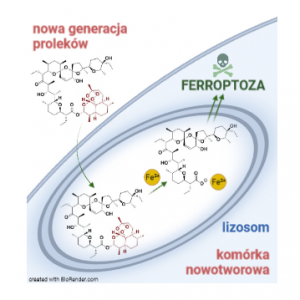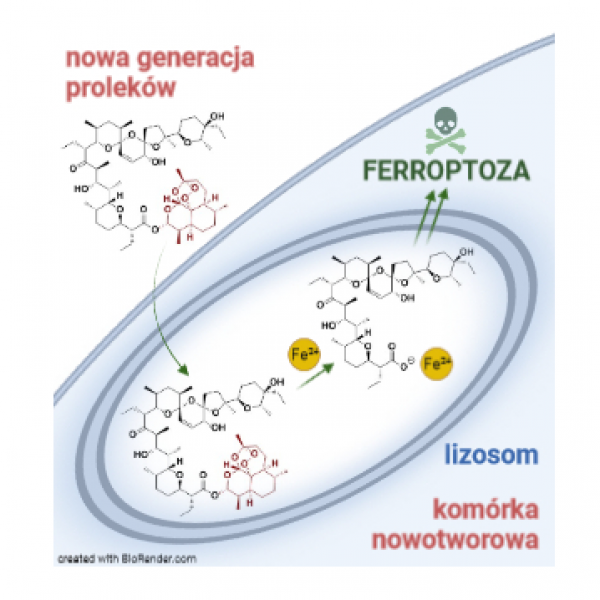Michał Antoszczak, Sebastian Müller, Tatiana Cañeque, Ludovic Colombeau, Nelson Dusetti, Patricia Santofimia-Castaño, Christine Gaillet, Alain Puisieux, Juan Lucio Iovanna, Raphaël Rodriguez: Iron-sensitive prodrugs that trigger active ferroptosis in drug-tolerant pancreatic cancer cells, Journal of the American Chemical Society 2022, 144, 26, 11536–11545. https://doi.org/10.1021/jacs.2c03973
Disturbed physiological equilibrium followed by uncontrolled cell division leads to formation of a tissue mass known as cancer. Initiation of the process of cancer formation requires a number of biochemical changes, including those taking place at the (epi)genetic level. Tumors are phenotypically diverse, which significantly hinders selective targeting at particular cancer cells by means of small molecules intervention. The paradigm of cancer stem cells (CSCs) describes a subpopulation of cells of high capacity of renewal and metastasis from the site of original appearance to distant tissues and organs. CSCs that are usually resistant to conventional therapies, may cause the disease relapse. The search of candidates capable of selective destruction of CSCs is a priority of many research groups and is expected to highly contribute to development of advanced oncological therapies.
In the screening studies in 2009 (Gupta et al., Cell 2009, 138, 4, 645‒659), a natural polyether ionophore, salinomycin, was identified as the most effective towards breast CSCs. Salinomycin was more active than nearly 16,000 other tested substances and nearly 100 times more active than paclitaxel – the cytostatic drug commonly used in therapies against this type of cancer. In view of the above, chemical modification of salinomycin structure, leading to its derivatives of even higher anticancer effectiveness (including strong effectiveness against CSCs) is an important task of top interest.
It is known that iron acts in a double role in cells, it may stimulate their growth but also lead to their death through ferroptosis. The question is if iron may be also harness to fight with cancers. Recent discoveries have proved the homeostasis of this microelement in cancer cells, including CSCs, pointing to iron and the processes it is involved in as potential new targets in the ongoing battle with cancerous changes. The article by Dr Michał Antoszczak, from the Department of Medical Chemistry, Faculty of Chemistry, AMU, and members of the group of Prof. Raphaël Rodriguez from the Institut Curie in Paris, presents results of the studies on new salinomycin prodrugs in which iron would act as a chemical trigger of particular components of the prodrugs, but on the other hand, it would be a mechanistic target of these compounds. The experiments performed on 2D and 3D cell growths permitted identification of the lead structures and explanation of their mechanism of anticancer activity. The prodrugs that were the hybrids of salinomycin and dihydroartemisinin and preferably accumulated in lysosomes could react with iron, which would lead to the release of biologically active molecules followed by inducing ferroptosis in the model of human breast CSCs, drug-resistant cells of pancreas cancer and organoids originating from a biopsy of pancreatic ductal adenocarcinoma. This discovery reveals the significance of the active form of ferroptosis, hitherto neglected feature of this modality of cell death, as an exciting new mode of fighting with CSCs and persistent drug-resistant cancer cells. The studies reported in this paper have opened the way to design new anticancer drugs acting through active ferroptosis.
The article is an outcome of the post-doctoral internship of Dr Michał Antoszczak in the group headed by Prof. Raphaël Rodriguez, financed by the National Science Centre through the competition Uwertura 3 (nr 2019/32/U/ST4/00092) and the National Agency for Academic Exchange in Mieczysław Bekker program, edition 2019 (PPN/BEK/2019/1/00034).


